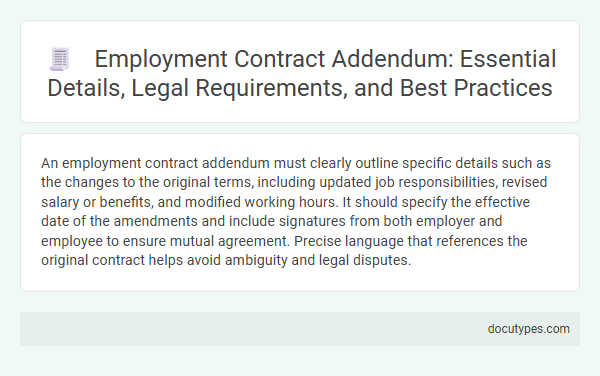An employment contract addendum must clearly outline specific details such as the changes to the original terms, including updated job responsibilities, revised salary or benefits, and modified working hours. It should specify the effective date of the amendments and include signatures from both employer and employee to ensure mutual agreement. Precise language that references the original contract helps avoid ambiguity and legal disputes.
Introduction to Employment Contract Addendums
An employment contract addendum serves to modify or clarify terms within the original agreement. It is essential for ensuring that both parties acknowledge and consent to any changes after the contract is signed.
- Identification of Original Contract - Clearly references the initial employment contract by date and parties involved to establish context.
- Detailed Description of Changes - Specifies the exact modifications, additions, or deletions to the original terms in clear, unambiguous language.
- Effective Date of Addendum - Establishes when the new terms will take effect to avoid confusion regarding the timing of changes.
Your signature, along with that of the employer, is required to validate the addendum and integrate it legally into the employment contract.
Purpose and Importance of Addendums
An employment contract addendum serves to update or clarify the terms of the original agreement without needing a complete rewrite. It ensures that new conditions or changes are legally acknowledged and enforceable.
Specific details must include a clear reference to the original contract, a precise description of the modifications, and the effective date of the changes. Both parties' signatures are essential to validate the addendum. Your addendum protects rights and maintains transparency throughout the employment relationship.
Key Elements in an Employment Contract Addendum
An employment contract addendum must clearly outline the modifications to the original agreement to avoid any misunderstandings. Including precise and relevant details ensures both parties acknowledge and accept the new terms.
- Reference to the Original Contract - Clearly identifies the original employment contract by date and parties involved to maintain legal continuity.
- Detailed Description of Changes - Specifies the exact clauses being added, amended, or removed, providing clarity on the new obligations or benefits.
- Effective Date - States when the addendum's terms will take effect to ensure timely implementation and enforcement.
Legal Requirements for Valid Addendums
Employment contract addendums must clearly specify the changes to the original agreement, such as modifications to job duties, salary, or work hours. Precise identification of the parties involved and the effective date of the addendum is essential for clarity and enforcement.
Legal requirements mandate that the addendum be signed by both the employer and employee to ensure mutual consent and validity. Compliance with local labor laws and inclusion of a reference to the original contract are critical elements for a legally binding addendum.
Common Scenarios Requiring Addendums
What specific details must be included in an employment contract addendum?
An employment contract addendum must clearly specify the changes or additions to the original contract terms. Common scenarios requiring addendums include salary adjustments, changes in job responsibilities, extension of contract duration, or modifications in work location.
Steps to Draft an Effective Addendum
| Step | Details to Include | Purpose |
|---|---|---|
| Identify the Original Contract | Reference the title, date, and parties involved in the initial employment contract | Establishes the connection between the addendum and the existing contract |
| Clearly State the Addendum's Purpose | Define the specific changes, additions, or clarifications being made to the original agreement | Prevents ambiguity and ensures all parties understand the scope of modifications |
| Specify Detailed Terms | Include precise information such as updated job responsibilities, revised salary, working hours, benefits, or contract duration | Ensures clear understanding of new or altered obligations and rights |
| Include Effective Date | State the date when the addendum's changes take effect | Clarifies the timeline for implementation |
| Address Conflict Resolution | Outline how conflicts between the original contract and the addendum will be resolved | Prevents legal disputes by prioritizing documents or specifying conflict hierarchy |
| Obtain Signatures | Include signature lines for all parties involved with dates | Confirms mutual agreement and legally binds the addendum |
| Maintain Consistency with Legal Standards | Ensure the addendum complies with applicable labor laws and company policies | Protects the validity and enforceability of the contract modifications |
Best Practices for Addendum Implementation
Employment contract addendums must clearly specify the changes or additions to the original agreement, including precise language detailing the scope of modifications. Essential elements include the effective date, parties involved, and references to the original contract clauses being amended.
Best practices for addendum implementation involve obtaining written consent from all parties to ensure legal enforceability and maintaining a formal record by attaching the addendum to the original contract. Regularly reviewing and updating documents guarantees alignment with current employment terms and compliance with labor regulations.
Risks and Pitfalls to Avoid
Employment contract addenda require precise and clear information to prevent legal complications. Overlooking critical details can lead to misunderstandings and disputes.
- Ambiguous Language - Vague terms can cause confusion about rights and obligations, increasing the risk of litigation.
- Incomplete Scope - Failing to specify the exact changes or additions may render the addendum unenforceable.
- Lack of Signatures - Omitting signatures or dates can invalidate the addendum and weaken legal protection.
Reviewing and Approving Addendums
An employment contract addendum must clearly specify the changes or additions to the original agreement, including updated job responsibilities, compensation adjustments, or altered work schedules. Reviewing and approving addendums involves thorough examination by both employer and employee to ensure mutual understanding and consent. You should verify that the document is signed and dated by all relevant parties to validate the amendment legally.
What Specific Details Must Be Included in an Employment Contract Addendum? Infographic

